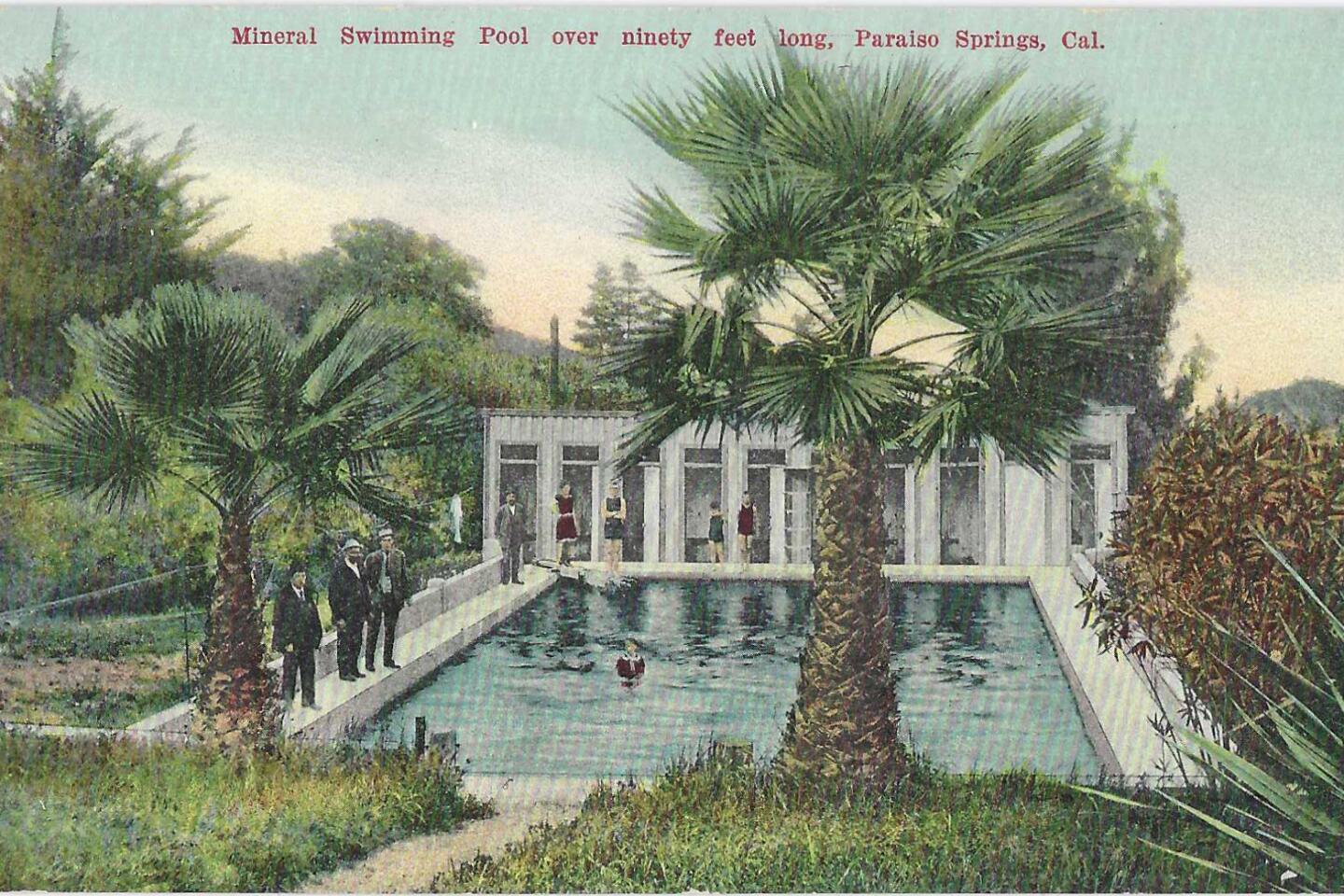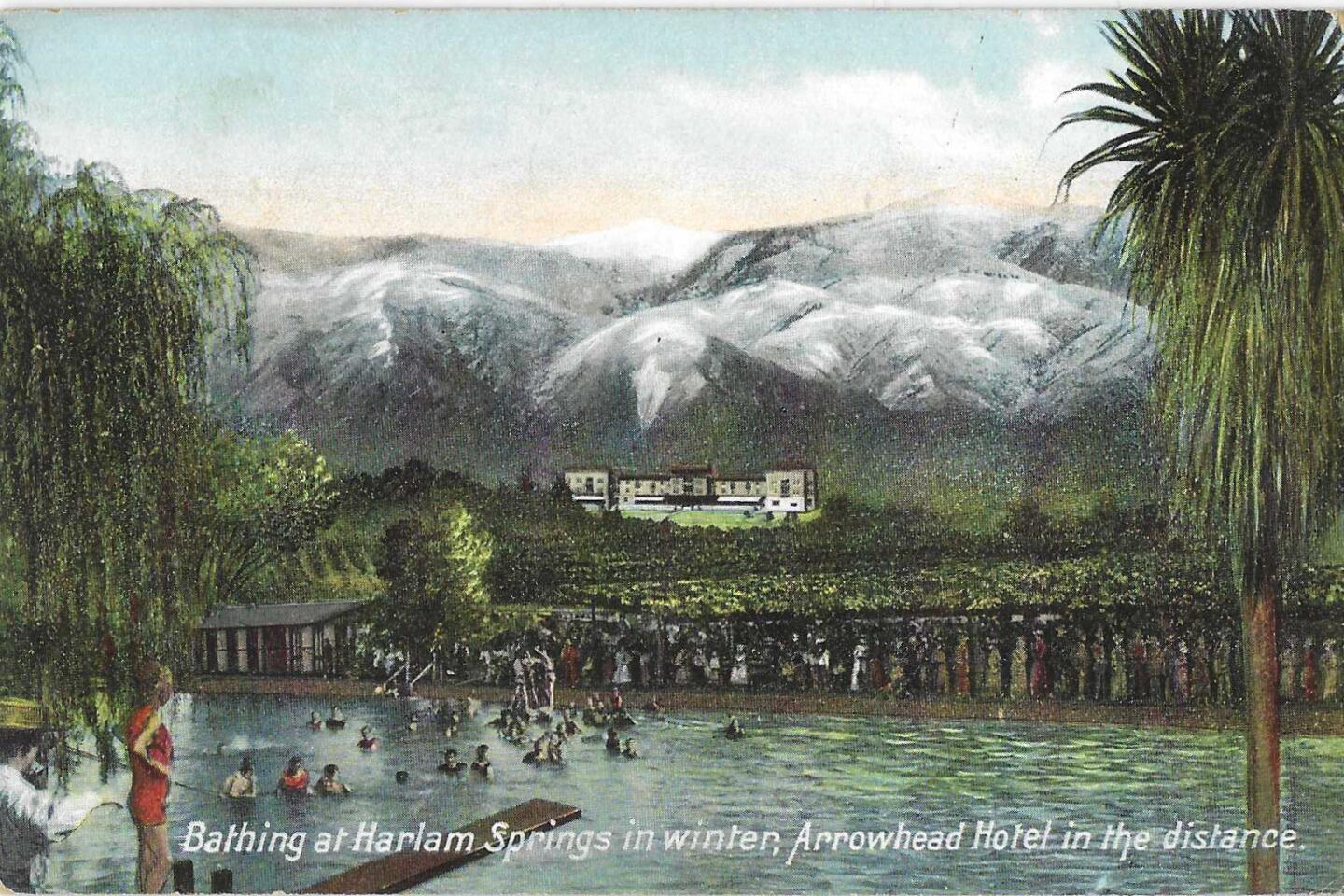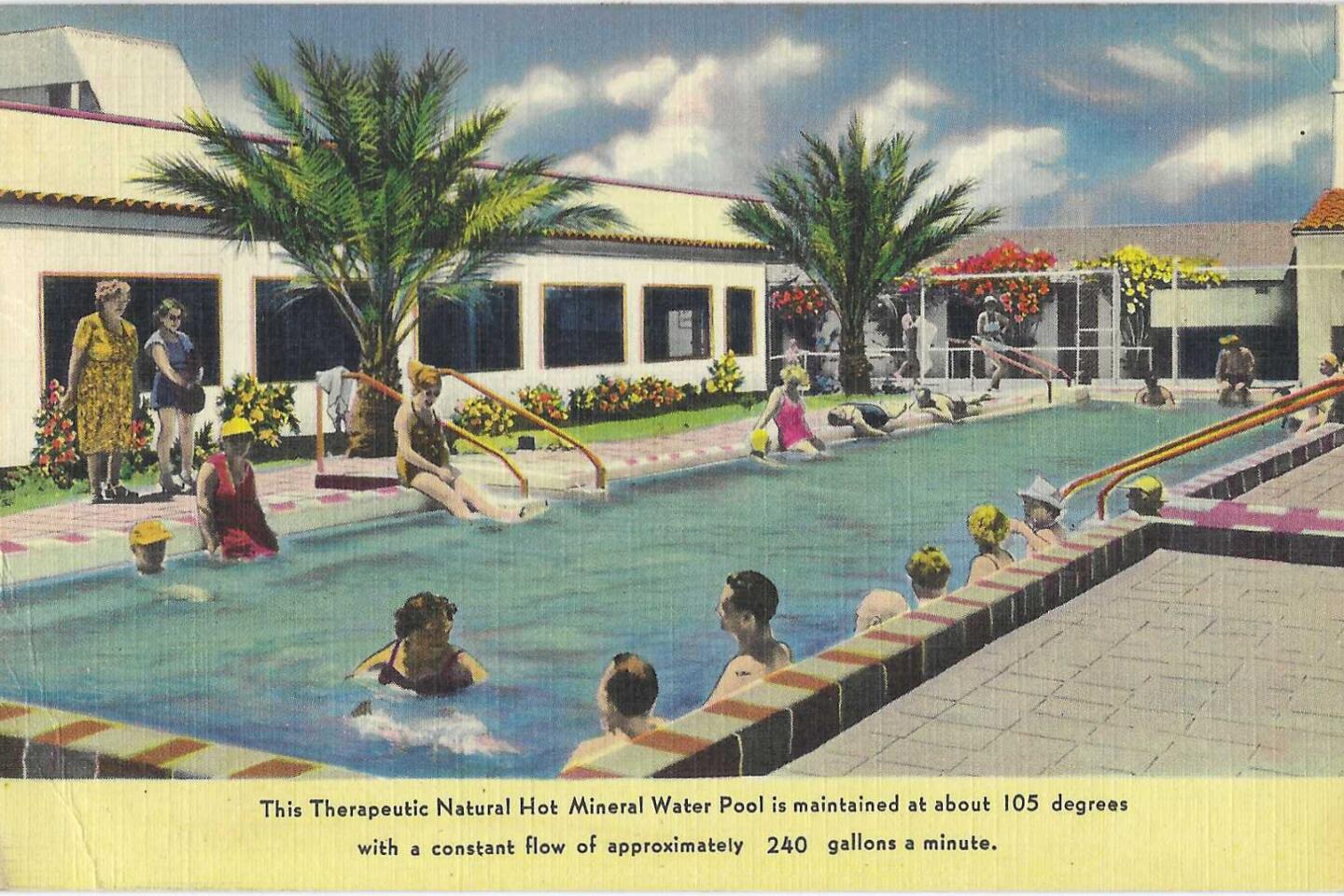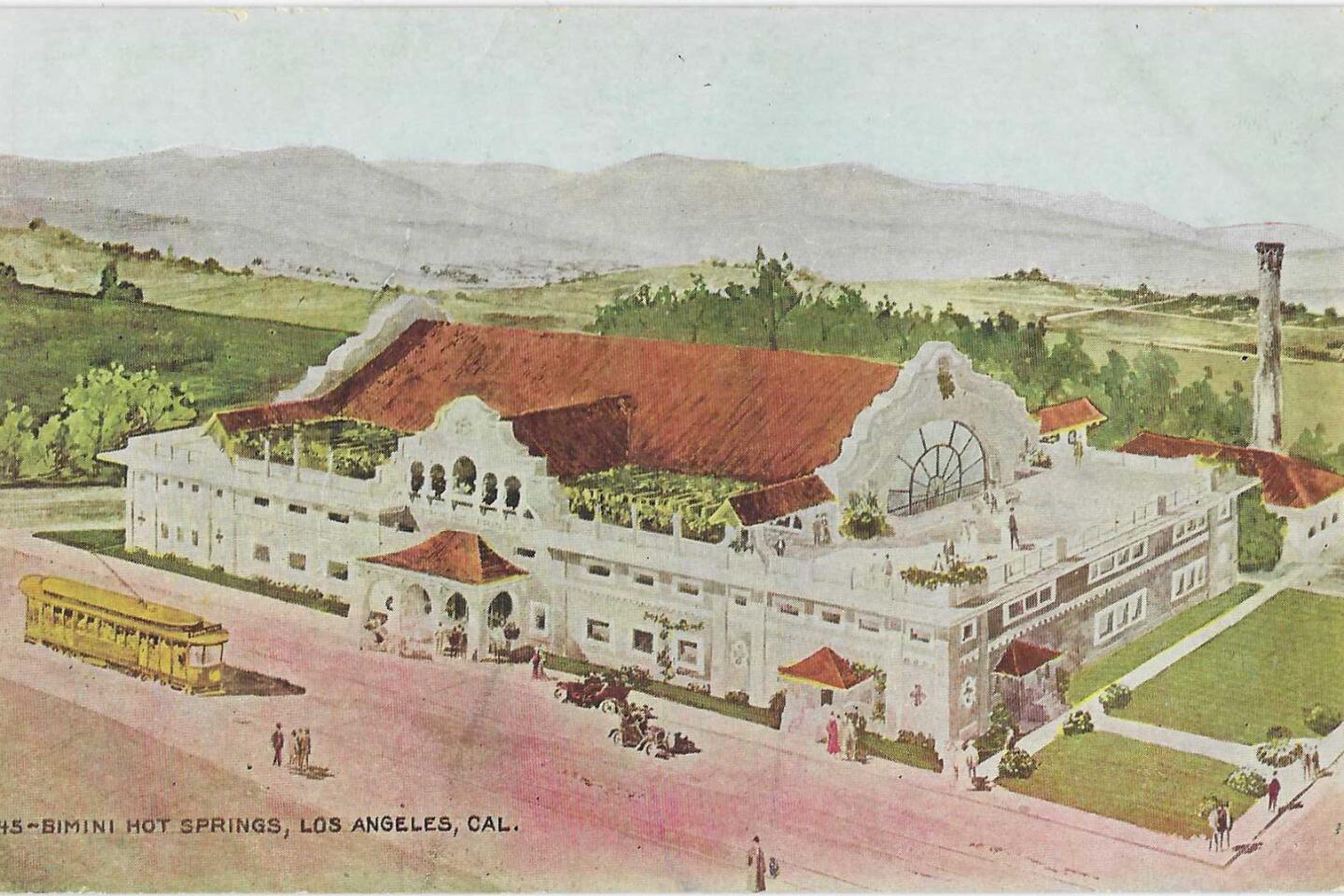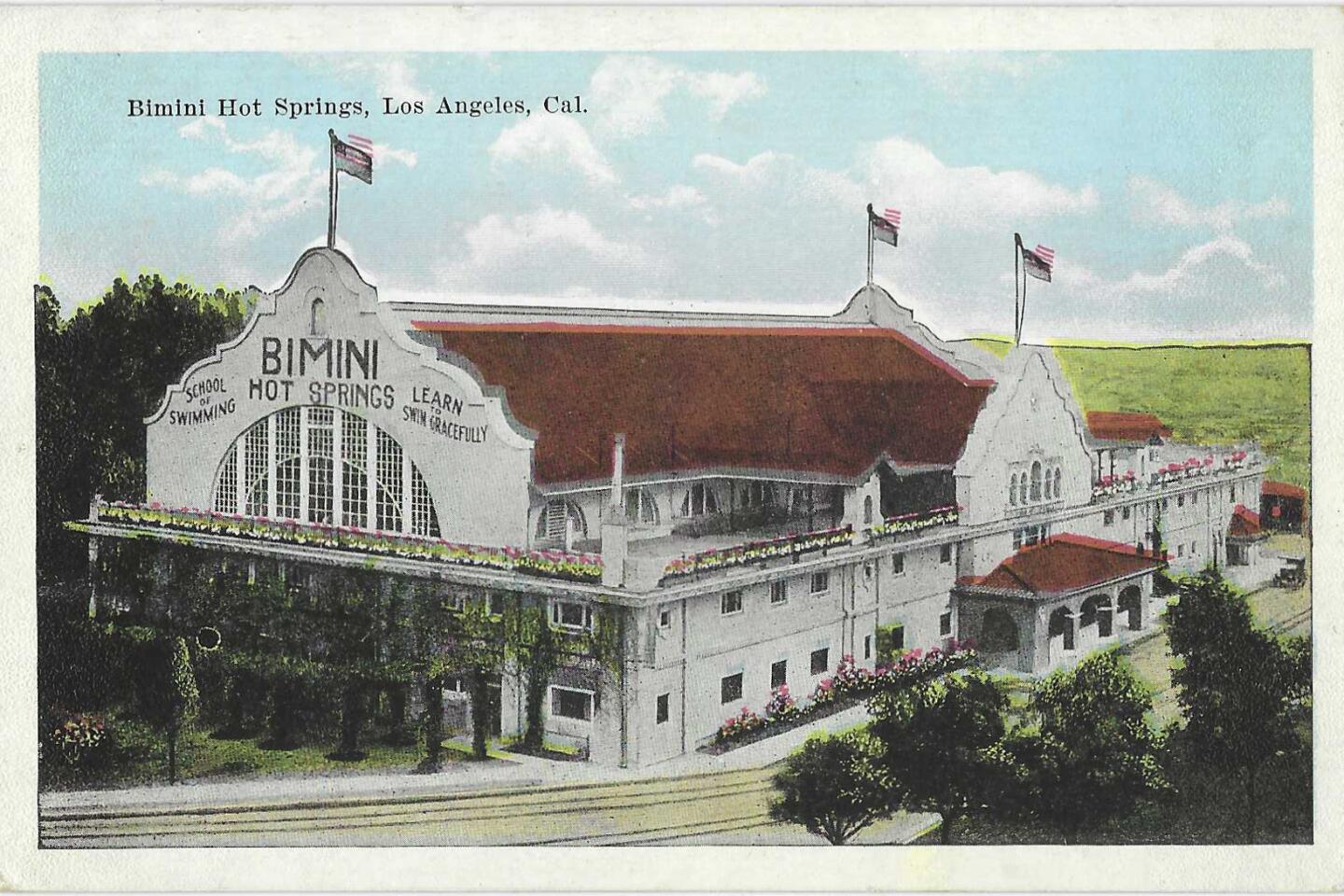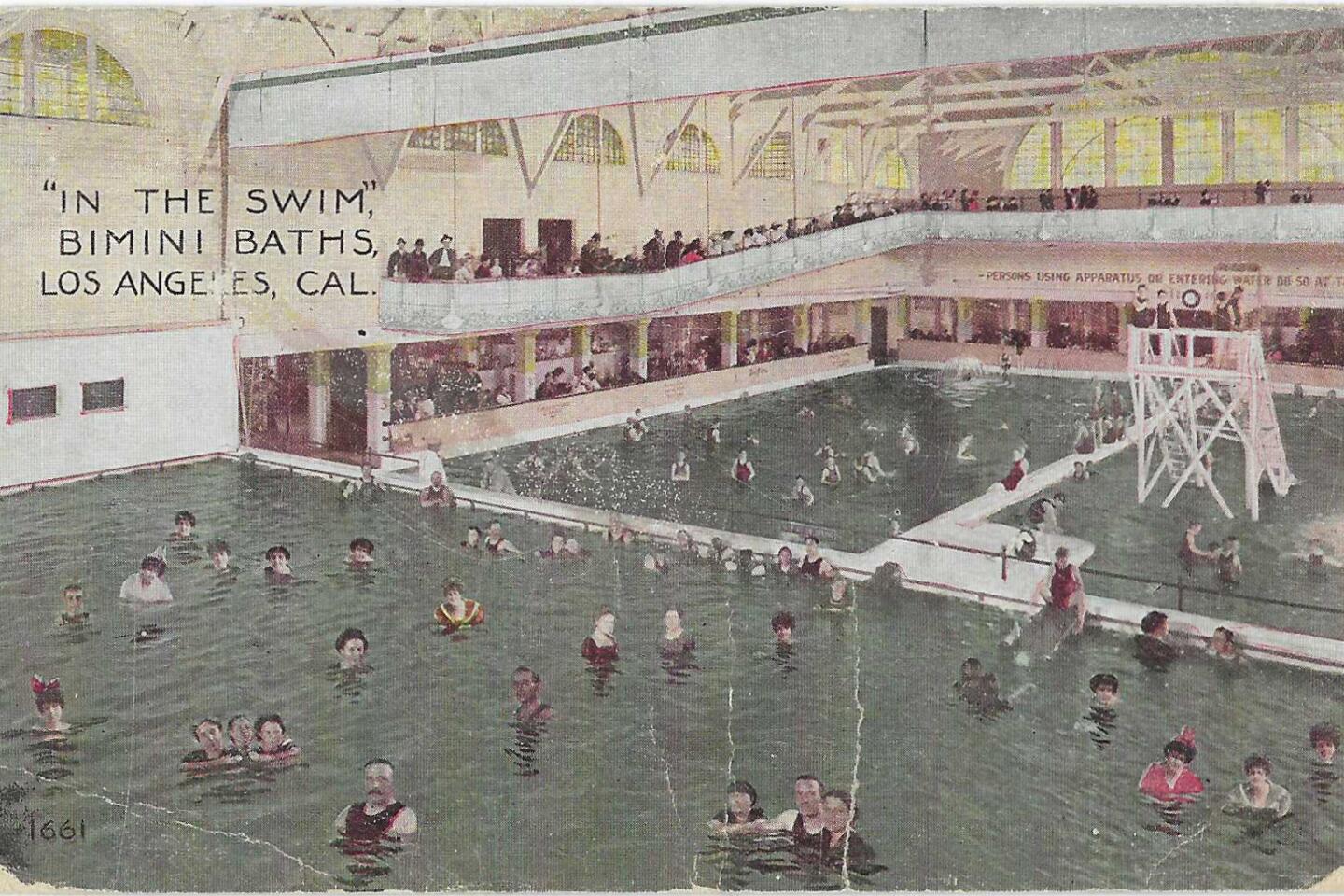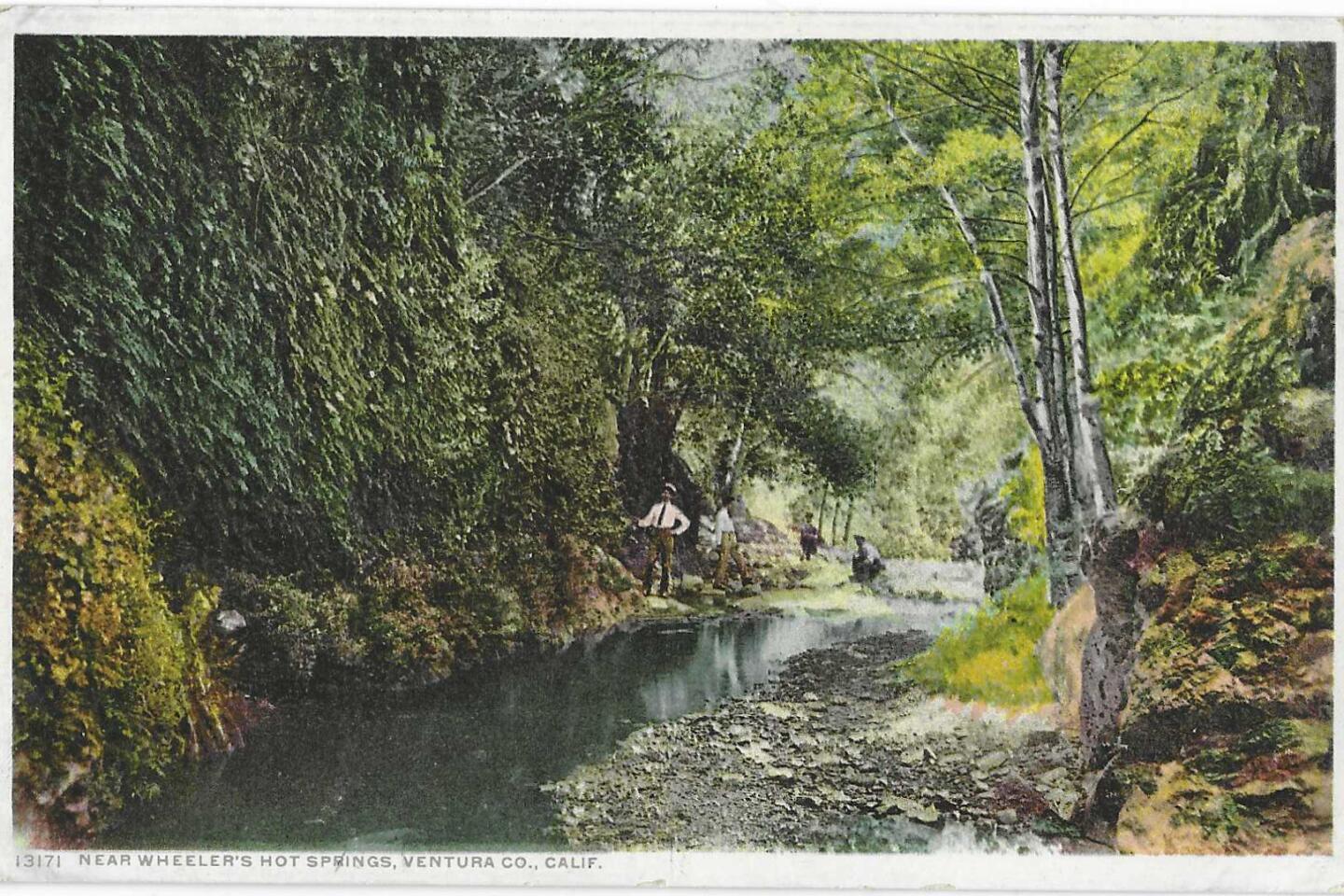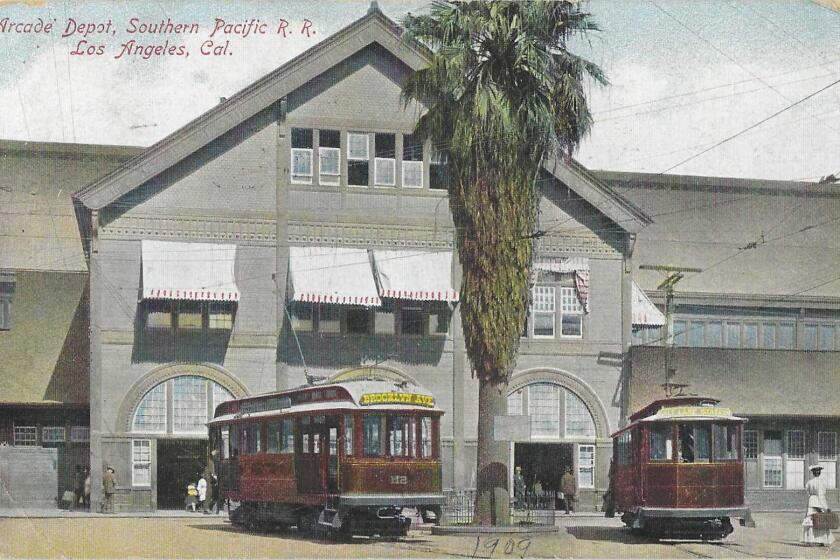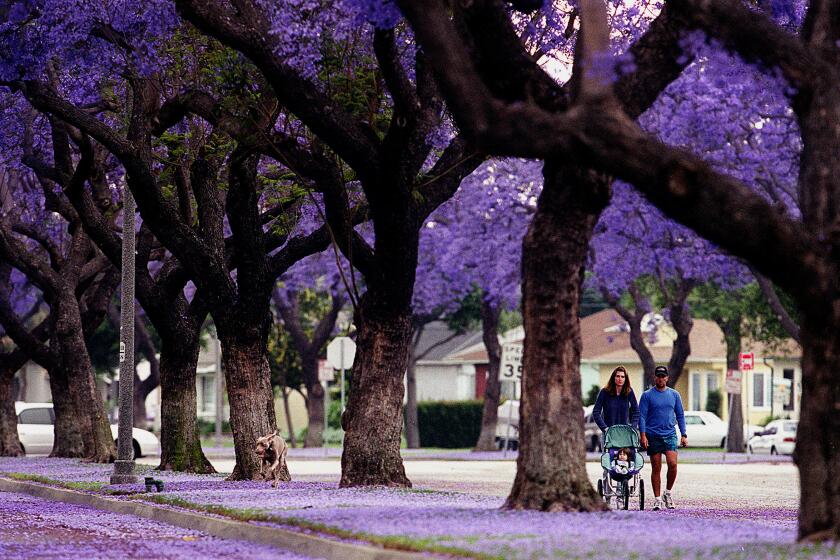From sacred to profane: A brief history of Southern California’s hot springs
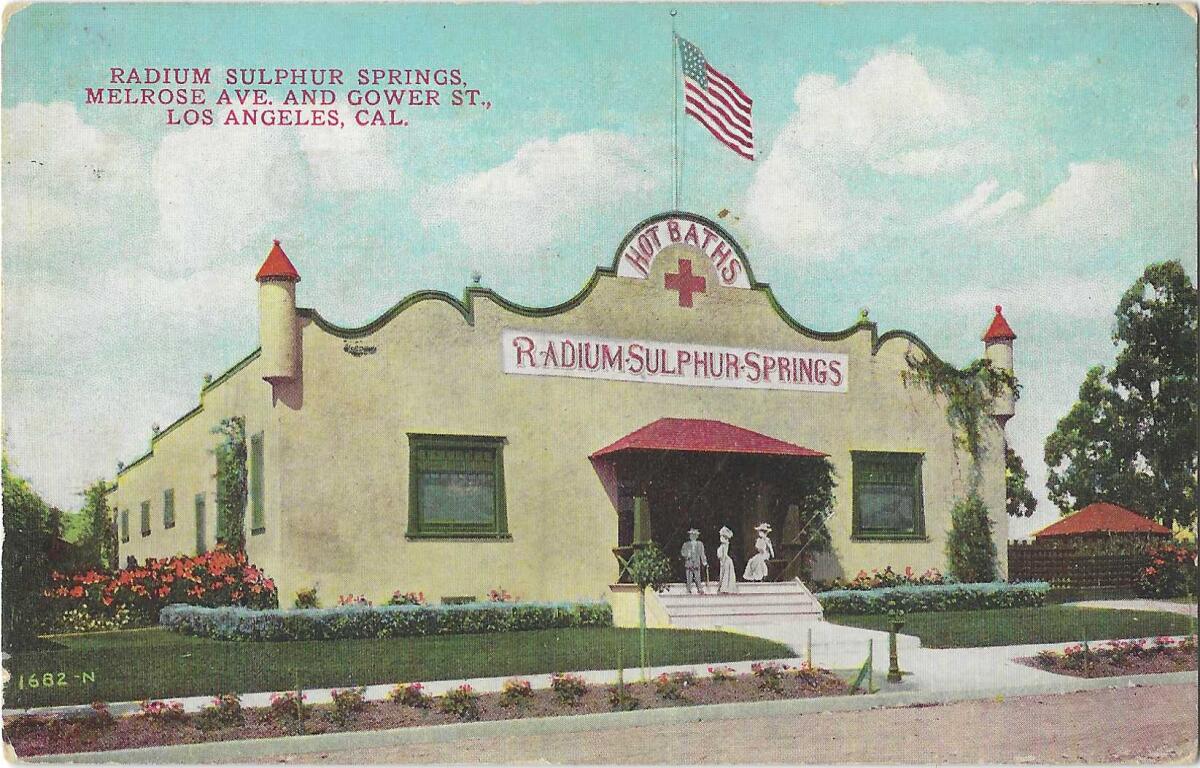
- Share via
Perhaps you will be among those who go to bed on Dec. 31, or who wake up on Jan. 1, with a head buzzing remorsefully from bubbles, or a gut overloaded with intemperate calories.
Even before breakfast, you will sign up for a year-long gym membership. You will search online for “cleanse diets.” You will make a vow of abstemiousness in food and drink. You might even decide that a weekend at a spa or a hot springs will set you on the path to a new, spartan you.
Just like so many Angelenos before you.
If the ground under our feet insists on jerking and rattling us to splinters and rubble once in a while, then it’s only fair that we should also get a bit of pleasure from our fickle geology. So I give you… the therapeutic hot spring, geothermal energy at its most sybaritic.
For centuries inland Southern California has been immersed in luxuriant spa waters. The San Juan Hot Springs at the edge of the Cleveland National Forest was appearing in tourist guidebooks as early as 1888. Other therapeutic destinations, some of them operating today, included Gilman Hot Springs near San Jacinto; Desert Hot Springs in the Coachella Valley; Glen Ivy Hot Springs in Corona; the virtually forgotten Penyugal Hot Spring in the San Bernardino Mountains; Coso Hot Springs in Inyo County, its “volcanic iron water” and fumaroles now entirely within the restricted boundaries of the China Lake naval air weapons facility; the hot springs of Elsinore, “city of springs;” and — smack between Death Valley and the Mojave National Preserve — the stunning Tecopa Hot Springs.
Explaining L.A. With Patt Morrison
Los Angeles is a complex place. In this weekly feature, Patt Morrison is explaining how it works, its history and its culture.
All of them — and all the hot springs across the nation — were known for millennia to Native Americans, who found in them sacred, spiritual and healing qualities. Native Americans wintered in Desert Hot Springs in the Coachella Valley. And then came the white settlers and the commercializing of the hot springs, effectively dispossessing them from their own lands, even though some tribes tried to assert their legal claims. In 1846, a farsighted Army lieutenant and topographical engineer, William Emory, became acquainted with the delights at Warner hot springs in San Diego County. He predicted then that “a day will come no doubt, when the invalid and pleasure-seeking portion of the white race will assemble here to drink and bathe in these waters.… “
In L.A., modern arrivals “took the water” in spanking-new spas. They bobbed and lolled in it, drank it — hot, sometimes sulfurous-smelling water that, as one ad promised, “sparkles and foams like champagne!”
On New Year’s Day in 1903, hundreds of Angelenos hopped, or crawled, aboard streetcars for the ride to the new Bimini Baths, an immense “natatorium” — a collection of swimming pools and restorative, relaxing hot springs — on Vermont Avenue between First and Third Streets, a part of town where geothermal water gushed up again and again.
It couldn’t have been a surprise when men digging for oil in a lively landscape of tar pits and earthquake faults and oil seeps and methane pockets instead struck a gusher of hot water.
Remember that for centuries, Los Angeles was in many places a marshy, spongy landscape. In the high summer of 1769, the Spanish marched through what is now Beverly Hills and named it “the meeting place of waters.”
Streams and freshets ran all over the Los Angeles landscape, and Arroyo de la Sacatela coursed virtually alongside the dozen or so acres of the Bimini Baths site. In the 1920s Los Angeles began a ruthless, multimillion-dollar campaign to bury its many streams and arroyos in underground culverts and storm drains, then fill in the streambeds so the new real estate could go on the market. Only the city’s small Bimini Slough ecology park and its manmade watercourse stand as a showpiece reminder of the landscape that was.
As for Bimini, it’s the name of a Bahamian island chain and the supposed site of the mythic Fountain of Youth quested after by Ponce de Leon, the early 16th century Spanish explorer. (That’s probably a fable dreamed up by a rival trying to make de Leon look gullible.) The Bimini Baths founder, David W. Edwards, chose “Bimini” from a poem by the splendidly named 19th century writer Hezekiah Butterworth, author of inspiring patriotic works for young readers, who wrote of a Bimini where a “fountain gives life to the dying / And youth to the aged restores.”
Los Angeles County has had several notable hot springs besides Bimini. These included:
- Seminole Hot Springs, off Mulholland Drive in the Santa Monica Mountains. Its waters were discovered in 1911, when men drilling for oil struck hot waters that were soon reputed to have curative powers for “those affected by rheumatism, stomach, liver and kidney troubles.” It closed in 1959.
- Warm Springs, above Castaic, in Elizabeth Lake Canyon. The springs produce a mere trickle of five gallons a minute, compared to the 100 gallons every 60 seconds from the gusher at Bimini.
- White Point Hot Springs, at the foot of bluffs in San Pedro, which was opened in 1917 by a pair of Japanese brothers. Their landlord, one of the Sepulvedas, later built a salt-water pool heated by sulfur springs. The FBI carried off the brothers after December 7, 1941, and the military took over the site. The golf course closed in 1933 and the clubhouse burned in 1951, but the hot and sulfurous waters remain in rocky pools along the shoreline.
- And my favorite, Radium Sulphur Springs, opened in 1908 on Melrose Avenue, in the village of Colegrove, annexed the next year by L.A. Its founder, G. P. Gehring, aggressively marketed the “germicidal and radioactive” waters as relief and cure for a dozen maladies, including alcoholism, female troubles and paralysis. As a bonus, Radium Sulphur Springs claimed that it “clears the complexion, makes the skin velvety, eyes bright, hair glossy.” It had its own sales doggerel: “Oh! How it sparkles! Oh! How it foams! It chases a microbe wherever it roams.”
How much if any radium was actually in radium springs waters? Hard to say; if you were lucky, none. The start of the last century was the age of medical discoveries, along with the quack remedies that exploited them. Radium, the element discovered by Marie and Pierre Curie, and other radioactive elements promised extraordinary things for medicine — imagine, seeing into the human body! (Madame Curie died from cancer, overexposed to her own discoveries.) The world went radium-crazy, falling for products like radioactive face cream, a “radiendocrinator” to wear at night “under the scrotum,” radioactive-treated long johns for adults and kids, and luminous numbers painted in radium on watch and clock faces. In one of the 1930s’ signature screwball comedies, “Nothing Sacred,” Carole Lombard is a “radium girl” mistakenly diagnosed as dying of radium poisoning. It really is a comedy — honest.
In 1904, The Times wrote about one W.L. Garner, a tubercular local railroad worker “snatched from the grave by radium” at the British-American Medical Institute at 859 South Figueroa, where, restored to health, he went to work operating the institute’s “electro-ozo-viro-radium treatment machine.”
General Motors? Big Oil? Big Rubber? The demise of L.A.’s streetcars stemmed from public policy and our own appetite for automobiles.
In banning deceptive packaging in 1938, federal laws pretty much put an end to radioactive therapies. Many decades later, I saw glass beakers purportedly from the Curies’ lab being sold in a Paris flea market, but I passed, remembering that Marie Curie’s lab notebooks are so contaminated that they’re stored in lead-lined boxes.
These hot springs and baths offered people of Victorian sensibilities a chance to frolic in the water in the name of good health. Primly, men and women were served by separate plunges. No liquor was served. But sin crept in anyway.
In 1908, a 15-year-old boy named Victor Lamar was found dead in a Bimini pool. It turns out he had been invited there by a man, and more than once. As he told his sister, “I went out to the baths with a man and had a good time. Wouldn’t you go out and have a good time for $3 or $4?” An autopsy ruled the boy was a victim of what was delicately called a “statutory crime.” His family sued Bimini Baths over poor supervision. And a Catholic priest from Oklahoma was identified in court proceedings as the man committing the acts. “It is also asserted,” The Times reported, “that he has on other occasions been guilty of similar offenses.”
Bimini Baths burned a couple of years after it opened, but was enthusiastically rebuilt and added on, with a hotel, bigger pools and a Mission-style façade. It staged diving exhibitions and sponsored a water polo team. Local athletes trained here for the 1932 summer Olympics in L.A.
By 1927, Radium Sulphur Springs had changed its name to Hollywood Mineral Springs, capitalizing on the local product, and now claiming treatments — not cures — for rheumatism, high blood pressure, neuritis and sciatica, and excess weight. It rebuilt its premises with sunken Roman baths lined in mosaic tiles and an on-site bottling plant. The waters effervesced like the 1920s themselves, but the solemn weight of the Depression evidently closed its doors.
You can determine L.A.’s seasons by our plant life. For example, right now, it’s jacaranda-blooms-stuck-to-your-windshield season. And to understand the Southern California landscape you see, you have to realize that, like you, it is probably not from around here.
One place remains as L.A.’s spa legacy. An artesian well, the Oxford springs, discovered in a wheat field near Beverly and Western in 1910, still supplies water to the Beverly Hot Springs spa. Until the city put in water mains in 1915, the quarter-million gallons that surged out of the well every day supplied the locals’ hot water needs, and for a time, the water was bottled under the Angelus Club label as “Wonder Water,” with the slogan, “Nature’s own formula.”
The Bimini baths closed in 1951, and the next year, the property was sold to a Chicago man who announced that he’d be turning it into a training center for wrestlers, boxers, and the general public — a gym, in other words. But by 1956, it was an insurance company office, and the vast swimming pools were drained and used for storage. By then, Angelenos of means were building their own swimming pools and Jacuzzis, and they no longer needed a civic natatorium.
- Share via
Watch L.A. Times Today at 7 p.m. on Spectrum News 1 on Channel 1 or live stream on the Spectrum News App. Palos Verdes Peninsula and Orange County viewers can watch on Cox Systems on channel 99.
More to Read
Sign up for Essential California
The most important California stories and recommendations in your inbox every morning.
You may occasionally receive promotional content from the Los Angeles Times.

